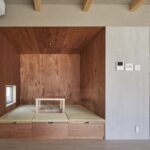Nestled in Nanjo, Japan, the House in Nanjo, designed by Spicy Architects, stands as a testament to traditional Okinawan architecture while embracing modernity. Completed in 2023, this residence caters to the needs of a family of three while paying homage to its cultural and environmental context.
Architectural Context
Situated on a hill within a residential area dating back to the 1980s, the house is surrounded by distinctive Okinawan dwellings characterized by flat roofs and expansive eaves. These architectural features serve to shield against subtropical storms and diffuse direct sunlight, influencing the design approach of the House in Nanjo.

Design Concept
Informed by the vernacular architecture of the region, the architects opted for a wooden structure, aligning with the context and functional requirements of the project. The house is meticulously arranged to feature a garden facing south and a garage facing east, strategically positioned to maximize natural light and shade throughout the day.
Exterior Aesthetics
Drawing inspiration from neighboring structures, the building’s shed and roof overhang are extended to create deep shadows, offering protection from the harsh sunlight. This design strategy not only enhances visual coherence within the neighborhood but also contributes to the overall aesthetic appeal of the house.
Interior Composition
The interior is characterized by a harmonious interplay of materials and colors, with gray tones dominating the palette to create a serene backdrop reminiscent of a canvas. Unpainted beams and furniture serve as focal points, imbuing the space with a sense of tranquility and understated elegance.

Sense of Comfort
Through careful volume control and material selection, the architects aimed to evoke a sense of comfort and intimacy within the space, in harmony with the laid-back local atmosphere. The result is a cohesive blend of tradition and modernity, where cultural heritage meets contemporary lifestyle.
Conclusion
The House in Nanjo epitomizes the successful integration of traditional architectural principles with contemporary design sensibilities. By honoring its cultural heritage while embracing innovation, Spicy Architects have created a residence that not only serves the needs of its occupants but also contributes to the rich tapestry of Japan’s architectural landscape.














